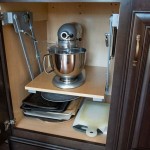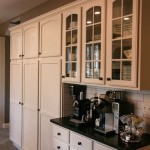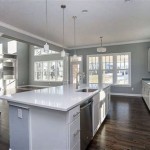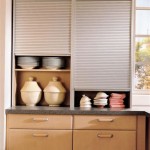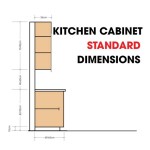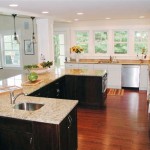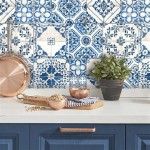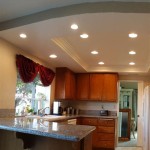Decorative End Panels On Kitchen Cabinets: Aesthetics and Functionality
Kitchen cabinets are a crucial element of any kitchen design, providing storage and contributing significantly to the overall aesthetic. While the cabinet doors and hardware often receive the most attention, the end panels, especially when decorative, can elevate the entire room's look and feel. Decorative end panels are essentially panels applied to the exposed sides of kitchen cabinets, providing a finished and often ornate appearance. Their purpose extends beyond mere concealment, blending functionality with decorative intent.
These panels offer an opportunity to enhance the cabinet's design and integrate it more cohesively with the kitchen's overall style. They can be customized to match or complement the cabinet door style, countertop material, backsplash, or even the flooring. This level of customization helps create a unified and polished appearance, transforming basic cabinetry into a more intentional design element. Furthermore, decorative end panels can be strategically used to camouflage imperfections or structural components within the cabinet construction, providing a clean and refined look.
Types of Decorative End Panels
The market offers a diverse range of decorative end panel styles, each catering to different aesthetic preferences and kitchen layouts. Understanding these types is essential for selecting the right panel for a specific project. The choice depends on factors like budget, desired style, and the existing kitchen design. Some common types include:
Flush End Panels: These panels are designed to sit completely flush with the cabinet frame, creating a seamless and minimalist look. They typically match the cabinet door style and are often used in contemporary or modern kitchens where clean lines are desired. The installation process involves meticulous alignment to ensure a perfectly even surface. Flush end panels provide a uniform appearance, enhancing the perceived quality of the cabinet system.
Raised Panel End Panels: Characterized by a raised center panel surrounded by a recessed border, these panels add depth and dimension to the cabinet's side. They are commonly found in traditional or transitional kitchen designs, adding a touch of elegance and sophistication. The raised panel design often incorporates intricate detailing, which can further enhance the visual appeal.
Recessed Panel End Panels: Conversely, recessed panel end panels feature a flat center panel set back from the surrounding frame. This style offers a more understated and classic look, complementing both traditional and contemporary designs. The simplicity of the design allows it to blend seamlessly with various kitchen styles. Recessed panels can be customized with different frame profiles to add visual interest.
Beaded End Panels: These panels incorporate vertical or horizontal beads, adding texture and visual interest to the cabinet's side. They are often used in farmhouse or cottage-style kitchens, creating a charming and rustic aesthetic. The beaded detailing can be subtle or more pronounced, depending on the desired effect. Beaded end panels provide a handcrafted feel, enhancing the warmth and character of the kitchen.
Furniture-Style End Panels: Resembling furniture legs or feet, these panels extend to the floor, giving the cabinets a built-in and furniture-like appearance. They are commonly used in high-end kitchens to create a luxurious and custom look. Furniture-style end panels often incorporate decorative moldings and carvings, further enhancing their visual appeal. Their design elevates the entire kitchen design, making the cabinets appear less utilitarian and more like fine furniture.
Applied Molding End Panels: Applied molding is used to create decorative designs directly on the end panel surface. This allows for a range of complex and unique designs, from simple geometric patterns to elaborate floral motifs. This type of panel provides flexibility in design, allowing it complement various kitchen styles or create unique focal points. The application process requires precision and skill to ensure a seamless and professional finish.
Glass End Panels: Less common but highly impactful are glass end panels. These can feature clear, frosted, or textured glass, offering a glimpse into the cabinet's interior or creating a decorative window effect. Glass end panels can work well with modern or contemporary designs, adding a unique touch of elegance and depth. When using glass, the interior of the cabinet must be organized and aesthetically pleasing.
Benefits of Using Decorative End Panels
Beyond aesthetics, decorative end panels offer several functional benefits that contribute to the overall quality and longevity of kitchen cabinets. Understanding these advantages can help homeowners make informed decisions regarding their kitchen renovation projects.
Enhanced Durability and Protection: End panels serve as a protective barrier for the exposed sides of cabinets, shielding them from everyday wear and tear. This is particularly important in high-traffic areas where cabinets are susceptible to accidental bumps, scratches, and moisture damage. Decorative end panels constructed from durable materials like solid wood or plywood can significantly extend the lifespan of the cabinets. They effectively minimize the impact of these external factors, preserving the cabinet's structural integrity and aesthetic appeal over time.
Concealing Imperfections: In some cases, the sides of kitchen cabinets may have visible imperfections, such as exposed seams, uneven surfaces, or unfinished edges. Decorative end panels provide an effective and aesthetically pleasing solution for concealing these flaws. They create a smooth and uniform surface, instantly improving the overall appearance of the cabinets. By covering up these imperfections, the end panels contribute to a more polished and professional look.
Creating a Finished Look: Decorative end panels contribute to a more complete and finished look by eliminating the raw or unfinished appearance of cabinet sides. This is especially important for cabinets that are visible from multiple angles within the kitchen or adjacent living spaces. The panels create a seamless transition between the cabinets and the surrounding walls or other architectural elements, enhancing the overall cohesiveness of the design. This attention to detail elevates the aesthetic appeal of the entire kitchen.
Customization and Design Flexibility: Decorative end panels offer a wide range of customization options, allowing homeowners to tailor the cabinet design to their specific preferences. They can be painted, stained, or finished to match or complement the existing cabinetry, countertops, backsplash, or flooring. This level of design flexibility allows homeowners to create a truly unique and personalized kitchen space. The ability to customize the end panels ensures that they seamlessly integrate with the overall design scheme, enhancing the visual harmony of the room.
Increased Home Value: Well-designed and properly installed decorative end panels can increase the perceived value of a home. Potential buyers often appreciate the attention to detail and the enhanced aesthetic appeal that these panels provide. The panels can be viewed as a premium upgrade, showcasing the homeowner's commitment to quality and design. This can be a significant selling point, especially in competitive real estate markets.
Factors to Consider When Choosing Decorative End Panels
Selecting the appropriate decorative end panels involves careful consideration of various factors to ensure that the chosen panels complement the existing kitchen style and meet the homeowner's aesthetic and functional requirements. A thoughtful approach will ensure that the addition of decorative end panels enhances the overall kitchen design.
Kitchen Style: The decorative end panel style should align with the overall design of the kitchen. For example, raised panel end panels are typically suitable for traditional kitchens, while flush end panels are better suited for modern or contemporary kitchens. Consider the existing cabinet door style, countertop material, and backsplash when selecting the end panel style. The chosen panel should seamlessly integrate with these elements, creating a cohesive and harmonious look.
Material Selection: Decorative end panels are available in various materials, including solid wood, plywood, MDF (Medium Density Fiberboard), and laminate. Solid wood offers durability and a premium look, while plywood provides a more cost-effective alternative with good stability. MDF is a smooth and paintable option, and laminate offers a durable and easy-to-clean surface. Consider the budget, desired aesthetics, and the level of durability required when selecting the material. The material should also be compatible with the chosen finish, such as paint or stain.
Finish and Color: The finish and color of the decorative end panels should complement the existing cabinetry and the overall kitchen color scheme. Matching the color is a safe choice, but a contrasting color can also create a visual impact. Consider the lighting in the kitchen and how it affects the appearance of different colors and finishes. Samples should be viewed in both natural and artificial light to ensure that the chosen finish is suitable for the space.
Panel Thickness: The thickness of the decorative end panel can affect its durability and appearance. Thicker panels generally offer greater structural integrity and a more substantial look. However, excessively thick panels may protrude too far from the cabinet frame, creating an awkward appearance. Consider the cabinet's existing dimensions and the desired aesthetic when selecting the panel thickness. A balanced approach will ensure that the panel provides adequate support without compromising the overall design.
Installation Method: Decorative end panels can be installed using various methods, including screws, nails, adhesive, or a combination of these. The chosen installation method should be appropriate for the panel material and the cabinet construction. Professional installation is generally recommended to ensure a seamless and secure fit. Proper installation will prevent the panel from shifting or detaching over time, preserving the integrity of the design.
Budget Considerations: The cost of decorative end panels can vary depending on the material, style, and installation method. Setting a budget before starting the project is essential to narrow down the options and avoid overspending. Compare the prices of different panels and installation services to find the best value. A well-defined budget will help guide the selection process and ensure that the project remains financially feasible.

End Panels Embellishments Diamond Cabinets

Decorative Cabinetry Panels Refrigerator End Ideas

Pin Page

Decorative End Panel Aokextras

Diy Cabinet End Panels With Shaker Style Trim Average But Inspired

Kitchen Remodel With Decorative End Panels Viking Cabinets

Kitchen Cabinet Decorative End Panels Everything You Need To Know

Decorative End Panels Portland Cabinet Cures

Cabinet Paneling Decorative Painted Panels

Kitchen Remodel With Decorative End Panels Viking Cabinets

